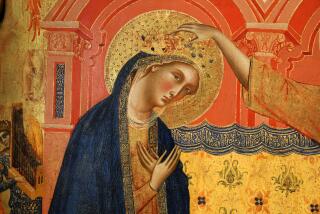Trashed Italian Museum Now a Treasure
- Share via
ROME — Under the gaze of Napoleon’s sculpted sister, topless in a Venus-like pose, the Borghese Gallery unveiled its restored art treasures Friday, overcoming physical ruin and bureaucratic feuds that kept most of the world-renowned museum closed for 13 years.
An eyesore of unfinished reconstruction that outlasted eight Italian ministers of culture and inflicted a seedy atmosphere on Rome’s biggest park, the Borghese finally reopened with 20 radiant rooms of painting and sculpture masterpieces under richly frescoed ceilings.
“It’s springtime after a long winter in our cultural patrimony,” declared Walter Veltroni, the ambitious new minister who is leading a nationwide campaign to restore rundown museums and archeological sites.
The Borghese’s demise exemplified decades of neglect of Italy’s cultural riches by a string of corrupt postwar governments that collapsed every few months. Veltroni, eager to show that a leftist-led coalition can get things done, has personally supervised the museum’s revival since last August.
Typical for Italy, work on the $30-million renovation went right up to deadline. Diplomats, VIPs and journalists invited to Friday’s two-hour opening often ran afoul of scaffolding, floor polishers and grumbling workers racing to tidy up the three-story museum before the ticket-buying public arrives today.
But the result is a display of the gallery’s treasure box-like rooms in their original splendor, as well as the artistic gems they hold.
The museum was the 17th century suburban mansion of Cardinal Scipione Borghese, a nephew of Pope Paul V who used political power, thievery and blackmail to expand his dazzling art collection. Its most famous piece was added two centuries later--Antonio Canova’s sculpted portrait of the reclining Paolina Borghese, Napoleon Bonaparte’s sister and the wife of Camillo Borghese.
The Italian government bought the home and the collection in 1902.
The gallery’s top two floors were closed in 1984 after a 10-square-foot chunk of ceiling fell from Giovanni Lanfranco’s fresco “The Council of the Gods.”
Architects found structural weaknesses caused by seismic activity, automobile traffic and water erosion of the catacombs below. They also found rotted plaster, termite-eaten moldings and grime.
As curators, archeologists, architects, engineers and city planners bickered over how to fix the problem, paintings by Botticelli, Bellini, Raphael, Caravaggio and Rubens languished.
The Borghese’s ground floor, with its ancient and neoclassical sculptures, remained open but was surrounded by construction equipment that discouraged visitors.
As late as the mid-1990s, guidebooks predicted that renovation would continue into the next century.
*
Veltroni, who grew up nearby, came to despise what he called “this dirty, decayed, ruined bunker” of a museum and the decline of the surrounding Villa Borghese park into a haven for drug addicts and homeless people.
“When I became minister, I told myself, ‘I can’t let anyone hate me as much as I hated all the previous ministers for letting this happen,’ ” he said in an interview.
So he set a deadline--June 28--and visited the place at least once a month to enforce a timetable. Using his clout as a deputy prime minister, he nearly tripled the culture ministry’s yearly budget, to $625 million, and sought private donors.
Italian banks paid for the cleaning of grime from Paolina Borghese and another famous sculpture, Gianlorenzo Bernini’s “Apollo and Daphne.”
The last patch of dirt is to be wiped from Paolina on live television tonight amid three days of fireworks, concerts and festivities to publicize the reopening.
More to Read
The biggest entertainment stories
Get our big stories about Hollywood, film, television, music, arts, culture and more right in your inbox as soon as they publish.
You may occasionally receive promotional content from the Los Angeles Times.










